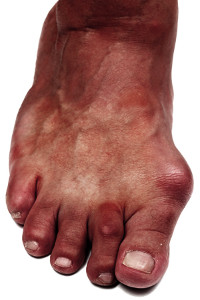 A bunion is typically found at the bottom of the big toe. It is comprised of a growth that appears to be of a bony texture, and severe pain is often experienced. The causes for this ailment developing may originate from a predisposed inherited gene or from an injury the foot has endured. There are several ways to determine if you have this condition, which may be noticing reddened skin, a tingling sensation, or swelling in the affected area. Treatment typically involves specific surgery that can be performed to remove the bunion or choosing a more conservative method where partial relief may be obtained. Recent research has shown that wearing shoes with a bigger toe area is helpful in accommodating the bunion, in addition to pads that are placed on the bunion which may help in relieving pressure. Seeking a consultation with a podiatrist is highly recommended if you are experiencing pain or discomfort.
A bunion is typically found at the bottom of the big toe. It is comprised of a growth that appears to be of a bony texture, and severe pain is often experienced. The causes for this ailment developing may originate from a predisposed inherited gene or from an injury the foot has endured. There are several ways to determine if you have this condition, which may be noticing reddened skin, a tingling sensation, or swelling in the affected area. Treatment typically involves specific surgery that can be performed to remove the bunion or choosing a more conservative method where partial relief may be obtained. Recent research has shown that wearing shoes with a bigger toe area is helpful in accommodating the bunion, in addition to pads that are placed on the bunion which may help in relieving pressure. Seeking a consultation with a podiatrist is highly recommended if you are experiencing pain or discomfort.
If you are suffering from bunions, contact one of our podiatrists of Jill Einhorn, DPM and James Einhorn, DPM. Our doctors can provide the care you need to keep you pain-free and on your feet.
What Is a Bunion?
A bunion is formed of swollen tissue or an enlargement of boney growth, usually located at the base joint of the toe that connects to the foot. The swelling occurs due to the bones in the big toe shifting inward, which impacts the other toes of the foot. This causes the area around the base of the big toe to become inflamed and painful.
Why Do Bunions Form?
Genetics – Susceptibility to bunions are often hereditary
Stress on the feet – Poorly fitted and uncomfortable footwear that places stress on feet, such as heels, can worsen existing bunions
How Are Bunions Diagnosed?
Doctors often perform two tests – blood tests and x-rays – when trying to diagnose bunions, especially in the early stages of development. Blood tests help determine if the foot pain is being caused by something else, such as arthritis, while x-rays provide a clear picture of your bone structure to your doctor.
How Are Bunions Treated?
If you have any questions, please feel free to contact our offices located in Brooklyn and Astoria, NY . We offer the newest diagnostic and treatment technologies for all your foot care needs.